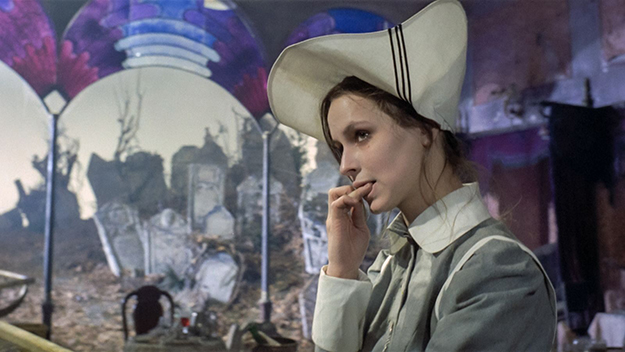Memory Palace
This article appeared in the March 22, 2024 edition of The Film Comment Letter, our free weekly newsletter featuring original film criticism and writing. Sign up for the Letter here.

The Hourglass Sanatorium (Wojciech Jerzy Has, 1973)
Poland is the birthplace of a number of modern cinema masters—Andrzej Wajda, Agnieszka Holland, Krzysztof Kieślowski, Krzysztof Zanussi, Jerzy Skolimowski, and Roman Polanski, to list but a few. None, however, was as consistently brilliant and also under-recognized as Wojciech Jerzy Has. Has’s international prominence grew in the ’80s, when his bold fantasy of interconnected picaresque tales, The Saragossa Manuscript (1965), found popularity as a midnight movie (the film was purportedly a favorite of Jerry Garcia, who helped fund a restoration project in the early ’90s). Has was, however, a remarkable realist, with a filmography full of intimate dramas that delve into life in a Poland devastated by the Second World War. The crippling nostalgia for a youth and innocence cut short by wartime trauma, and doomed romantic entanglements, were among his favored themes. At the same time, his naturalism contained a kernel of surreality; he was obsessed with time’s psychological dimension—its fragmentation and subjectivity. Whereas the characters of Andrzej Wajda, Has’s close contemporary, are dramatically entwined with historical events, Has’s protagonists dwell on history’s margins, haunted by existential dilemmas and memories.
Born in 1925, in Kraków, Has studied at the city’s Academy of Fine Arts, perhaps the source of his incredible visual sensibility, for which he was honored at the 2000 International Film Festival of the Art of Cinematography Camerimage, in Lódź, shortly after his death. Has’s impressionistic approach, and his consummate interest in adapting challenging literary texts to the screen, perhaps also accounts for his being lesser known outside his native Poland than many of his colleagues. The “Long Strange Trips of Wojciech Jerzy Has” retrospective at Film at Lincoln Center helps address the filmmaker’s relative obscurity, featuring 14 of his feature films, made between 1957 and 1988, in addition to a program of his early fiction and documentary shorts.
Has’ debut feature, The Noose (1958), tells the story of a day in the life of Kuba (Gustaw Holoubek), an alienated alcoholic, who must fill the hours until his girlfriend takes him to a clinic. It is a nerve-wrecking grind for Kuba, his resolve to stay sober challenged every passing minute by friends and strangers and by the minefield of alcohol advertisements in Kraków. Scored with piercing string music, The Noose is stunningly choreographed, its tempo punctuated by events—for instance, a bus accident, possibly caused by either a drunk driver or a clock being repaired in the street—that heighten Kuba’s awareness of passing time, and his dread.
The legacy of Second World War looms large in The Noose, and even more so in How to Be Loved (1963) and The Codes (1966), both of which deal with the impenetrability of memory. In these films, war trauma instills in survivors an acute temporal sensibility: nothing feels real anymore, and the past becomes more vivid than the present, though its meaning proves elusive. In How to Be Loved, an adaptation of a novel by Kazimierz Brandys, Barbara Kraftówna brilliantly portrays Felicja, a successful radioplay actress who hid her lover, Wiktor (Zbigniew Cybulski), from the Gestapo during the war. As she’s chatting with some passengers on a flight to Paris, we see this past in vivid flashbacks, while the voiceover relays her inner musings. Has again explores subjectivity, contrasting Felicja’s banal small talk with the horrors of war. Her sacrifices, including enduring rape, spared Wiktor from the Nazis but not from survivor’s guilt.
In The Codes, an older man (Jan Kreczmar) arrives in Kraków to find the truth behind the arrest and death of his son, Jędrek. But when meeting Jędrek’s former comrades from an underground resistance group, he receives conflicting versions of his son’s wartime bravery and his fate. In both films, memory becomes unreliable in the face of the war’s upheaval of societal hierarchy and mores, throwing existential dilemmas into sharp relief. Even when dramatic historical events make up the backdrop of his romantic melodramas, Has is attuned to the subtle interchanges of erotic and intellectual power between his male and female protagonists. In The Doll (1968), Has’s lyrical adaptation of an 1890 novel by Bolesław Prus, an enterprising merchant in 19th-century Warsaw courts the finicky daughter of a ruined aristocrat. The film received mixed reviews in Communist Poland: Has stripped the novel—which analyzes society as a political organism—of its moral positivism, to focus instead on the elusiveness of romantic love and material wealth, maximizing the allure of historical sets with painterly, dreamy undertones.
Love, both symbolic and carnal, is also a major theme in Has’s late masterpiece, The Hourglass Sanatorium (1973), based on the novel by famed Polish-Jewish writer Bruno Schulz. As with The Doll, audiences were wowed by the film’s opulent, fantastical sets and rich array of props and costumes. Unlike Has’s other, more naturalistic dramas, whose protagonists return to family hearths to encounter a new post-war world, The Hourglass Sanatorium depicts an entirely phantasmagoric world, narrativizing the tragic fate of Polish Jews. A loving son, Józef (Jan Nowicki), visits his father at a once magnificent but now decaying sanatorium, where he soon loses his grip on reality. As he time-travels through long-gone estates, synagogues, and markets, Józef is haunted by feverish visions from his father’s past, his own adolescent sexual reveries, and the nightmarish tableaux of battlefields, heroes, emperors, and rabbis. In this sense, The Hourglass Sanatorium, along with The Saragossa Manuscript, is Has’s most expansionist exploration of time as a sublime antiquarium of all real and imagined pasts. In his uncanny ability to engage all the senses, Has transports us to places, and states, that defy reason.
Ela Bittencourt is a writer and critic. Her essays on art, the moving image, and books have appeared in Artforum, Film Comment, Harper’s, The Nation, The New York Review of Books, and other publications.







